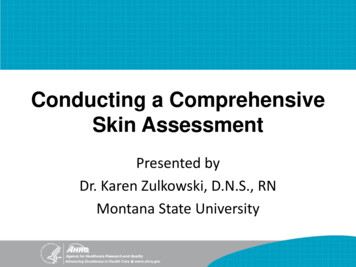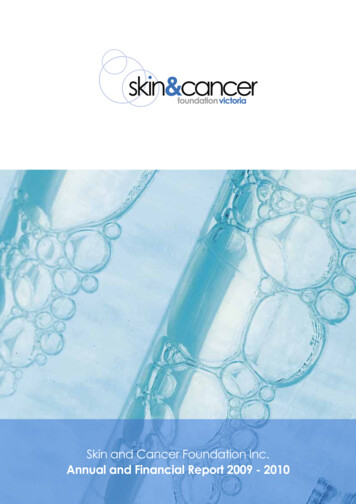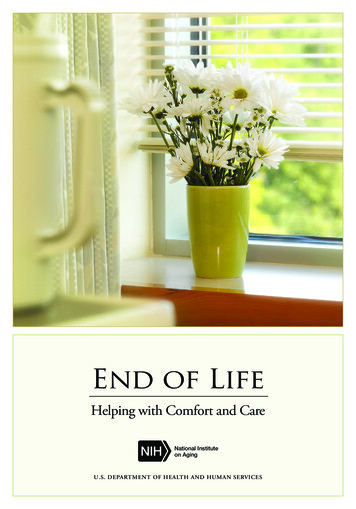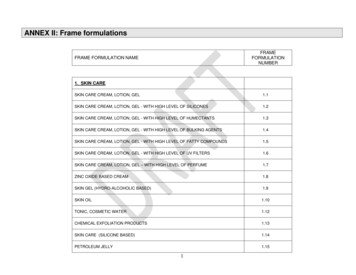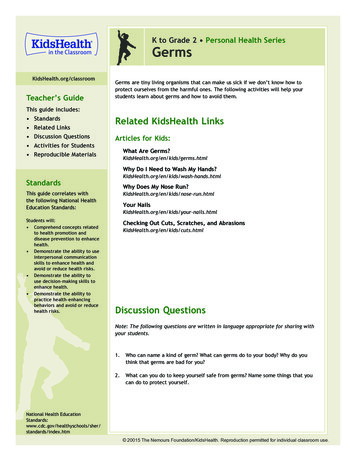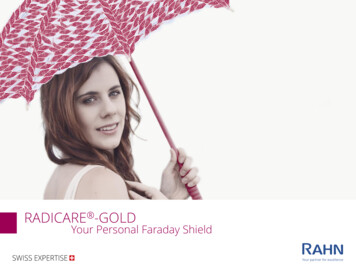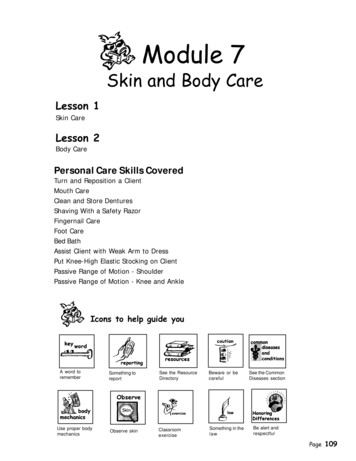
Transcription
Module 7Skin and Body CareLesson 1Skin CareLesson 2Body CarePersonal Care Skills CoveredTurn and Reposition a ClientMouth CareClean and Store DenturesShaving With a Safety RazorFingernail CareFoot CareBed BathAssist Client with Weak Arm to DressPut Knee-High Elastic Stocking on ClientPassive Range of Motion - ShoulderPassive Range of Motion - Knee and AnkleIcons to help guide youA word torememberUse proper bodymechanicsSomething toreportSee the ResourceDirectoryBeware or becarefulObserve skinClassroomexerciseSomething in thelawSee the CommonDiseases sectionBe alert andrespectfulPage109
Module 7- Lesson 1Skin CareWhat you will learn in this lesson:Skin CarePressure UlcersPersonalCareServices1. A caregiver’s role in client skin care, including: promoting healthy skin; routinely observing a client’s skin; knowing the types of skin problems to look for; documenting and reporting skin problems immediately.2. What pressure ulcers are and how to help prevent them.DefinitionModule 7 - Lesson 1Skin CarePage110Nurse DelegationWhen an RN delegates nursing tasks to qualified NACsor NARsPressure ulcers orPressure soresSkin breakdown or injury caused by pressure thatdamages the skin and underlying musclePressure pointsPlaces on the body where the bone causes thegreatest pressure on the muscles and skinSelf-Directed CareWhen an in-home client directs an Individual Provider tohelp him/her with health related tasksSkin breakdownAny break in the skin, creating a risk for infection andfurther injurySterile dressingA protective, bacteria-free, covering put on an injury
Skin Care Use moisturizing creams and lotions. Gently apply lotion to dry skin regularly. 3. Keep the skin dry. Use pads or briefs that absorb urine and keep moisture away from theskin for clients with incontinence. Use a cream or ointment as furtherprotection for the skin. Avoid using “blue pads” or disposable waterproof under pads that can holdmoisture on the skin. A waterproof cloth pad that can be laundered andreused is a good alternative. A caregiver can NOT: change sterile dressings; apply a prescribed lotion or ointment used to treat a condition (unlessunder Nurse Delegation or Self-Directed Care). A caregiver can apply: non-prescribed ointments or lotions (e.g. dandruff shampoo or body lotionto prevent drying of skin); or change a band-aid in response to a first-aid situation. 2. Keep skin, nails, hair, and beards clean. Set up a routine bathing schedule. When bathing, use warm, not hot, water, and mild soaps. Monitorwater temperature to avoid burns for any client who has lost the abilityto feel heat. Take extra care to make sure skin folds are clean and dry for clientswho are obese. Skin folds hold bacteria, dirt, and old skin cells. In-between baths, clean the skin as soon as you see something on it.PromotingHealthy SkinCare 1. Keep skin clean. There are five ways to help a client keep his/her skin healthy. Skin is the first line of defense a client has to heat, cold, and infection. Skinchanges as we age and sometimes because of a chronic illness. Thesechanges can lead to the: skin becoming thinner and dryer - tearing easier and not healing as easily; loss of the layer of fat just below the skin, decreasing the ability to staywarm; sweat glands losing the ability to cool in heat; loss of the ability to feel pain, heat, or light touch. The four important caregiving roles in client skin care include:1. Promoting healthy skin.2. Routinely observing a client’s skin.3. Knowing the types of skin problems to look for.4. Documenting and reporting problems immediately.Module 7 - Lesson 1Skin CarePage111
Encourage good nutrition. Diet contributes a great deal to healthy skin. Encourage a client to eat ahealthy, well-balanced diet and to drink plenty of fluids (unless on a fluidrestriction). See pages 135-142 for more detailed information about goodnutrition and page 148 for more information about getting enough water.5.Encourage mobility. Encourage a client to stay as mobile as possible. Encourage activities or exercise that help increase circulation. 4.Skin Problems a Caregiver May SeeType of ProblemPressure Ulcers(or Bed Sore)Stasis/Venous UlcersWhat is it?Skin breakdown or injury caused by pressure and/or weakened skinthat damages the skin and underlying muscle.A chronically open area, caused by poor circulation of the blood in theveins. Early symptoms are a rash or a scaly, red area and itching.The skin around the ulcer becomes a discolored reddish-brown. Thisoccurs most often on the lower legs and feet.Arterial UlcersRound open areas on the feet and lower leg due to lack of blood flowto the legs.Rashes and InfectionsMost rashes are raised, red, bumpy areas on the skin that are oftenitchy. Skin infections are a break in the skin, like a scratch, wherebacteria have spread and caused an infection.BurnsSkin Cancer/LesionsModule 7 - Lesson 1Skin CarePage112Skin that is damaged by fire, sun, chemicals, hot objects or liquids, orelectricity. Burns are classified according to how deeply the skin isdamaged. 1st degree burns are when the skin is reddened andmaybe swollen and tender. 2nd degree burns usually have blisters,intense redness, pain and swelling. 3rd degree burns are the mostserious and involve all layers of the skin.Abnormal growth on the skin that usually doesn’t spread and istreatable. A more dangerous kind of skin cancer is melanoma.Melanomas are irregularly shaped and may be described as a“strange mole” or a mole that is changing. If a client has a strangemole, encourage him/her to contact his/her doctor.
Observe a client’s skin whenever you are doing personal care. Look at the client’sskin at least once a day.What to Look For Redness or other changes in coloringSwellingChanges in temperature (warm or cold)A break in skinRashes, sores, or a gray or black scab over a pressure pointOdorPain Pressure Ulcers High risk for pressure ulcersClients who are fully or partially immobile or with weakened skin are at high riskfor getting a pressure ulcer. This includes clients: in wheelchairs or who spend a lot of time in a chair or bed; who have had a pressure ulcer in the past; who are paralyzed; who have unmanaged incontinence; with poor nutrition or dehydration; with a chronic illness, like diabetes, that decreases circulation; with cognitive impairments that make him/her forget to move; who have a decreased ability to feel sensation; who are obese or too thin. Pressure ulcers can also be caused when the skin is weakened by: friction; too much moisture on the skin; dryness and cracking; age; irritation by urine or feces; lack of good nutrition and/or drinking enough fluids; certain chronic conditions or diseases - especially those that limit circulation. The amount of pressure needed to cause a pressure ulcer ranges from a smallamount of pressure for a long time to high pressure for a short time. What causes pressure ulcersImmobility is the number one cause of pressure ulcers. When a person sits orlies in a position too long without moving, the weight of his/her body putspressure on the skin and muscle. The pressure can be from a bone pressingagainst another part of the body or from a mattress or chair. This unrelievedpressure cuts off blood supply to the skin. Without a blood supply, the skin and eventually the muscle under it - dies and a pressure ulcer forms. Observing any of these signs could be an indication of a skin problem and should bereported to the appropriate person in your care setting.Module 7 - Lesson 1Skin CarePage113
What pressure ulcers look likeWhat a pressure ulcer looks like depends on how severe it is. The first signs ofa pressure ulcer include: redness on unbroken skin lasting 15-30 minutes or more in people with lightskin tones. For people with darker skin tones, the ulcer may appear red,blue, or purple. If in doubt, compare the area to the other side of theclient’s body. any open area - it may be as thin as a dime and no wider than a Q-tip. an abrasion/scrape, blister, or shallow crater. texture changes - the skin feels “mushy” rather than firm to the touch.Module 7 - Lesson 1Skin CarePage114A pressure ulcer can sometimes look like a gray or black scab. Beneath thescab is a pressure ulcer. If you notice a scab over a pressure point, report itto the appropriate person in your care setting. Do not remove the scab. If apressure sore is beneath it, this could cause damage or lead to infection.
massage the area or the skin around it. use a heat lamp, hair dryer, or “potions” that could dry out the skin more. Do not: What to do if you see a problemAnytime you see redness on unbroken skin or feel heat in the area lasting15-30 minutes or more - especially at a pressure point: reposition the client off of the red area immediately to remove pressurefrom the area. report it to the appropriate person where you work. Make sure you knowahead of time who to report to about this kind of situation. Document yourconcerns. Pressure pointsPressure points are likely areas for pressure ulcers.Module 7 - Lesson 1Skin CarePage115
A client needs to change position frequently to protect his/her skin. A pressureulcer can start in as little as one to two hours for clients in bed and unable tomove. Clients who sit in chairs and can’t move can get pressure ulcers in evenless time because the pressure on the skin is greater. Changing aClient’s Position A client confined to bed should change position at least every2 hours. A person confined in a chair or wheelchair should shift his/her weight in the chair at least every 15 minutes for 15 secondsand change position at least every hour. Preventing friction to the skinFriction is caused when skin is rubbed against or dragged over a surface. Evenslight rubbing or friction on the skin may cause a pressure ulcer - especially forthose clients with weakened skin. Special care by a caregiver must be made when transferring and positioning aclient. A client must always be: lifted - not dragged when transferring; positioned in a chair or bed correctly so he/she cannot slide down; positioned on smooth linen or clothing.Skill: Turn and Reposition a Client in Bed1. S.W.I.P.E.S.2. Bend client’s knees.3. Before turning client, move client’s body towards self.4. Place your hands on the client’s hip and shoulder and gently roll the client over onhis/her side away from you.5. Position client in proper body alignment: head supported by pillow; shoulder adjusted so client is not lying on arm and top arm is supported; back supported by supportive device; top knee flexed, top leg supported by supportive device with hip in properalignment.6. Cover client with top sheet.7. Remove gloves (if used) and wash hands as final step.Module 7 - Lesson 1Skin CarePage116
Module Scenario Skin care tips for positioning a client confined to a bed or chair A special mattress that contains foam, air, gel, or water may be used. Adoctor or the case manager can help the client get special equipment.Check the mattress daily to make sure it is working properly. Do not use donut-shape cushions. They reduce blood flow and causetissue to swell. This increases the risk of a client getting a pressure ulcer. Choose a position that spreads weight and pressure most evenly. Use pillows or wedges to keep knees or ankles from touching each other. Place pillows under the client’s legs from mid-calf to ankle to keep a client’sheels off the bed if a client can’t move at all. Never place pillows directly behind the knee. It can affect blood circulationand/or increase the risk of blood clots. Be cautious about raising the head of a bed. This puts more pressure onthe tailbone and allows the client to slide, possibly causing a pressure ulcer.Lying flat can be a problem for clients who have difficulty breathing. If thisis the case, the head of the bed should not be raised at more than a 30 angle, unless necessary for breathing. Avoid positioning a client directly on the hipbone when he/she is lying ontheir side. Tuck pillows behind a client’s back when in this position. The following are general tips to remember when repositioning a client. Make sure there is room to roll the client. Tell the client to look in the direction they are being rolled. Do not roll the client by pulling or pushing on his/her arm.Mr. Bernard is a 44-year-old client who had a stroke (CVA) six months ago. Theresults from the stroke have left Mr. Bernard depressed. He has weakness onhis left side and needs help with many care tasks including positioning himself inbed. Since this morning, Mr. Bernard has refused to get out of bed and hasstayed in the same position for several hours.RESEARCH:Review page 321 on stroke (CVA) and page 305 for depression. Review information on pages113-117 on pressure ulcers and changing a client’s position.PROBLEM SOLVE:1. Identify what problem(s) a caregiver needs to address in this situation.2. Pick one problem and brainstorm ways to solve it. Pick a solution.3. How does this impact how a caregiver provides care?DEMONSTRATEOne group will demonstrate for the class repositioning Mr. Bernard in his bed, making sure toavoid pressure on areas at risk for skin break down.Module 7 - Lesson 1Skin CarePage117
Module 7- Lesson 2Skin and Body CarePersonal HygieneAssisting a Client toDressWhat you will learn in this lesson:1. Your role in helping a client perform personal hygiene, bathing,body care, and getting dressed.DefinitionModule 7 - Lesson 2Body CarePage118Body careHelping the client with exercises, skin care, andchanging dry bandagesPersonal hygieneCleaning and grooming of a person, includingcare of hair, teeth, dentures, shaving, and filingof nailsRange of motionHow much a joint can move
PersonalHygiene See the Resource Directory page 267 for more information on gum disease,dry mouth, and oral cancer. Watch for, document, and report any sore areas in the mouth,changes in tissue, complaints a client may have in eating comfortably,or anything unusual inside the client’s mouth. To help prevent decay and gum disease, teeth should be brushedtwice a day with fluoride toothpaste (if available). It is even better tobrush after every meal. Teeth should be flossed at least once a dayto clean between the teeth where the brush misses. Mouth careProper care of the mouth and teeth supports a client’s overall healthand helps prevent mouth pain, eating difficulties, speech problems,digestive problems, tooth decay, and gum disease. Personal hygiene is a very important part of helping to keep a client’s skinand body healthy. Being well-groomed is also an important psychological andphysical boost for most people. This lesson covers the personal hygiene tasksyou may be asked to help a client do.Skill: Mouth Care1. S.W.I.P.E.S.2. Ensure client is in an up-right sitting position.3. Put on gloves.4. Place towel across client’s chest before providing mouth care.5. Moisten toothbrush or toothette and apply toothpaste.6. Clean entire mouth (including tongue and all surfaces of teeth), with brush ortoothette, using gentle motions.7. Assist client to rinse his/her mouth.8. Hold basin to client’s chin.9. Wipe client’s lips and face, and remove towel.10. Dispose of soiled linen in soiled linen container.11. Clean and return toothbrush, toothpaste, etc. to proper storage.12. Remove gloves and wash hands.Module 7 - Lesson 2Body CarePage119
When assisting with brushing, use short, circularmovements, gently brushing the teeth with amassaging motion around each tooth. Makesure to work in a pattern so no teeth aremissed. A soft bristle toothbrush is recommended by dentistsand should be replaced when the bristles get worn (normallyevery three months). Make sure you have good light and can see what you are doing. Be careful not to touch the toothbrush bristles or any oral health item toother surfaces such as the counter, the sink, your bare hands, etc. Do not contaminate faucets, drawer handles, or other surfaces by touchingwith gloves that have been in contact with the client’s mouth. If a client has difficulty grasping a toothbrush, make the handle bigger witha sponge, rubber ball, or adhesive tape. An electric toothbrush may beeasier to manage than a manual brush in this case. Toothettes, moistened gauze pads, or “Oral-B Brush-Ups” may not cleanthe teeth completely and can push food further into the spaces betweenthe teeth. These products are useful in cleaning mouth tissues when theclient has no or just a few teeth, or for a client who is unable to open his/her mouth.The following are general tips when helpinga client with flossing. Start with a strand approximately 18 incheslong. Use a prethreaded flosser or floss holder (agreat assistive device), or wrap the flossaround the middle finger of both hands. Use your thumbs and forefingers to controlthe floss. Gently ease the floss between the client’s teeth using a gentle back andforth motion. The following are general tips when helping a client with mouth care.Module 7 - Lesson 2Body CarePage120 Carefully rub up and down, gently moving the floss from under the gum lineto the top of the tooth. Keep the floss against the tooth so you don’tinjure the gums. If a client has not flossed before or recently, the gums may bleed whenyou floss. If the client has heavy deposits on his/her teeth, it may bedifficult to get the floss between his/her teeth.
Watch for, document, and report any problems a client may have with denturessuch as discomfort, trouble eating, speech problems, complaints of thedentures not fitting correctly, sore spots under or around the denture, or odor. Denture CareLike natural teeth, dentures must be properly cared for to last. If the clientdoes not have any teeth or wears dentures, gums and mouth should bebrushed and cleaned at least twice daily.Skill: Clean and Store Dentures1. S.W.I.P.E.S.2. Put on gloves.3. Line sink/basin with a towel/washcloth or by filling it with water.4. Obtain dentures from client or gently remove them from client’s mouth if he/she isunable to do so. Take the lower denture out first, then the upper denture.5. Rinse dentures in cool running water before brushing them.6. Apply toothpaste or denture cleanser to toothbrush.7. Brush dentures on all surfaces.8. Rinse all surfaces of denture under cool, running water.9. Rinse denture cup before putting dentures in it.10. Place dentures in clean denture cup with solution or cool water.11. Return denture cup to proper storage.12. Clean and return supplies and equipment to proper storage.13. Dispose of sink liner. Do not put dentures in hot water - it can warp them. Avoid hard-bristled toothbrushes that can damage dentures. rinsed. Place clean dentures on clean surfaces, such as the denture cup after it is They are also slippery. Take extra care to avoid dropping them. Dentures can chip, crack, or break even if only dropped a few inches. Inspect dentures for cracks, chips, or broken teeth. dentist’s recommendations or the client’s preference). Allow dentures to soak overnight (or for several hours, depending on The following are general tips when helping a client with denture care. 14. Remove gloves and wash hands.Module 7 - Lesson 2Body CarePage121
Ask the client what denture cleaning product he/she uses. Hand soap, milddishwashing liquid, or special denture cleaners are all acceptable. Do not usepowdered household cleaners that are too abrasive. Don’t let dentures dry out - they lose their shape. Do not soak dentures in bleach water. Bleach can remove the pink coloring,discolor the metal on a partial denture, or create a metallic taste in a client’smouth. Never soak a dirty denture. Always brush first to remove food debris.Skill: The Shave (With Safety Razor)1. S.W.I.P.E.S.2. Put on gloves.3. Ask client if he/she wears dentures. If so, make sure they are in his/hermouth.4. Wash face with warm, wet washcloth.5. Apply shaving lather to the area you are going to shave.6. Hold razor securely.7. Hold skin taut with free hand and shave with smooth even movements inthe direction of hair.8. Rinse safety razor in warm water between strokes to keep the razor cleanand wet.9. Shave sides first, then nose and mouth.10. Wash, rinse, and dry face.11. Clean equipment and put away.12. Remove gloves and put in appropriate container.The following are general tips when helping a client withshaving. Do not press down hard or move the razor/shaver too fastover a client’s face. Shave the most tender areas of the face (the neck areabelow the jawbone) first and then move up to the tougherareas of the face between the ears, nose, and mouth. 13. Wash hands as final step.Module 7 - Lesson 2Body CarePage122Clients taking blood thinning medication should be encouraged touse an electric razor.
If using an electric razor, Clean the shaver’s screen and cutter regularly. It is good to clean ashaver after every third shave, and best after every shave. If a client has a circulatory problem or diabetes, you may not cut theclient’s toe or fingernails. Nail careNail care includes both fingernails and toenails. Nail care may be a part ofthe bath routine. All electric razors are not the same. It takes time for a client’s face toadjust to using a different brand electric shaver.Skill: Fingernail Care1. S.W.I.P.E.S.2. Put on gloves.3. Put water in bowl. Test water temperature to make sure it is safe and comfortable before placing client’s fingers in water. Adjust if necessary.4. Place water at a comfortable level for client.5. Put client’s fingers in water and allow to soak.6. Dry client’s hand including between fingers. Pat, don’t rub dry.7. Clean under nails with orange stick. Wipe orange stick on towel after each nail.8. Groom nails with file or emery board.9. Finish with nails smooth and free of rough edges.10. Empty, rinse, wipe water bowl, and return to proper storage.11. Dispose of soiled linen properly.12. Remove gloves and wash hands.The following are general tips when helping a client with fingernailcare. Sawing back and forth with an emery board and going too deepinto the corners can split and weaken nails. Go from side to sidein one direction or file each nail tip from corner to center. Cuticles act as a barrier to infection. Do not clip them. Apply a moisturizing cream or lotion to the hands and cuticlesafter you are done.Module 7 - Lesson 2Body CarePage123
Skill: Foot Care1. S.W.I.P.E.S.2. Put on gloves.3. Put water in basin. Test water temperature. Ensure it is safe and comfortablebefore placing client’s feet in water. Adjust if necessary.4. Put the client’s foot completely in the water.5. Supporting foot and ankle properly throughout procedure, remove foot fromwater, wash entire foot, including between toes, with soapy washcloth.6. Rinse and then dry entire foot, including between toes. Pat, don’t rub dry.7. Gently clean dirt out from under nails using orange stick.8. File or cut nails, straight across, as needed with clippers or emery board.9. Put lotion in your hand and massage lotion on client’s entire foot. Removeexcess (if any) with towel.10. Assist client to replace socks and shoes.11. Empty, rinse, wipe bath basin, and return to proper storage.The following are general tips when helping a client with foot care. Inspect your client’s feet regularly for changes in color (especially redness),temperature, blisters, cuts or scratches, cracks between the toes, or otherchanges. Document and report any swelling or redness you notice aroundthe area. Monitor minor cuts and keep them clean. Do not put lotion in-between the toes - the lotion causes moisture thatpromotes fungal growth. Do not cut down the corners of a client’s toenails or dig around the nail witha sharp instrument. Never cut the nails too short as this may cause ingrown toenails. After cutting, file the nails downwards. 12. Remove gloves and wash hands.Module 7 - Lesson 2Body CarePage124 Cuticles act as a barrier to infection. Do not clip them.
Bathing equipmentIdeally, the bathroom should have the followingequipment: bath mat; bath bench; hand held shower; grab bars in the right places. Older people and some people with chronic illnesseshave less skin oil and perspiration. Therefore, theymay not need a daily bath or may only need asponge bath. How often baths should be given depends on theclient’s physical condition, age, skin type, andpersonal wishes. Bathing can take place in a tub,shower, in a bed, or as a sponge bath. Baths givenin the tub may be more enjoyable for the client ifhe/she is able to do so. BathingA bath leaves all of us feeling refreshed and in a more relaxed frame of mind.A bath serves other important purposes for a client, including it: cleans the skin; stimulates circulation; provides movement and exercise; provides an opportunity to observe the client’s skin. Make sure the bathroom is warm and without drafts. Make sure the lighting is good. Fragile skin requires a very gentle touch. Use less soap - too much soap increases skin dryness. The following are general tips when helping a clientwith a bath. When assisting with a bath, start at a client’shead, work down and complete his/her frontfirst, unless the client has another preference. If the bathroom does not have these items, talkwith the appropriate person where you work to findout how a client can get needed equipment.Module 7 - Lesson 1Body CarePage125
Skill: Bed Bath1. S.W.I.P.E.S.2. Put on gloves.3. Remove or fold back top bedding. Keep client covered with bath blanket or topsheet.4. Remove client’s gown/sleep wear.5. Test water temperature and ensure it is safe. Adjust if necessary. Replace thewater at anytime it gets soapy, cool, or dirty.6. Wet washcloth (no soap) and begin with the eyes. Use a different area of thewashcloth for each eye, washing inner to outer corner.7. Wash the rest of the face, ears, and neck, using soap (if the client prefers).8. Rinse. Dry areas with a towel – pat, don’t rub.9. Expose one arm and place a towel underneath it. Support the client’s arm withthe palm of your hand underneath the client’s elbow. Wash the client’s arm,shoulder, and armpit. Rinse and pat dry.10. Place the client’s hand in the water basin. Wash the client’s hand, rinse, andpat dry. Repeat with the other arm and hand.11. Wash, rinse, and pat dry the client’s chest and abdomen.12. Uncover one of the client’s legs and place a towel lengthwise under the footand leg. Bend the knee and support the leg with your arm. Wash the leg,rinse, and pat dry.13. Slide the client’s foot in to the water basin. Wash the client’s foot, rinse and patdry. Repeat with the other leg and foot.14. Assist the client to turn on his/her side, away from you. Place a bath blanketor towel along side his/her back.15. Wash the client’s back and buttocks, rinse and pat dry.16. Assist the client to his/her back. Provide privacy and let the client perform his/her own perineal care (Assisting with this will be covered later).17. Assist client to get dressed.18. Assist the client to get up, or assist in a comfortable position if remaining in bed.19. Remove bedding that may have gotten wet.20. Empty, rinse, wipe bath basin and return to proper storage.21. Place soiled clothing and linen in proper container.22. Remove gloves and wash hands.Module 7 - Lesson 2Body CarePage126
Assisting aClient to Dress clothes made of fabric that stretches, such as knits; items that fasten in front including front-fastening bras, blouses, shirts, andpants; pants and skirts that pull on; Types of clothingCertain types of clothing also can make it easier for the client to get dressed,including: Assistive devices for dressingThere are many helpful tools to assist a person to dress independently. Yourjob may be to assist the client in using these tools to get dressed. Examples ofcommon tools are: velcro in place of buttons or shoelaces. zipper pulls attached to a zipper’s metal tab to give the client added leveragein closing and opening the zipper. A large paper clip can also be used. extended shoehorns that allow the client to get on his/her shoes withoutbending over. Clients who have had a stroke or are paralyzed for other reasons are likely tohave had some rehabilitation and instruction on how to dress. Clients who need assistance with dressing often have difficulty doing things thatrequire small finger movements like buttoning, zipping, putting on socks, and/orlacing up shoes. Look for skin problems, especially at pressure points and feet. well so he/she doesn’t slip. When assisting a client off a bath bench, make sure the person is dried off avoiding force and over-extending limbs and joints. If help is needed, make sure to move body parts gently and naturally, Encourage the client to do as much as he/she can. or off of the equipment. Make sure all equipment is secured and locked before assisting someone on Make sure the floor is dry when assisting someone in or out of a shower. The following are general tips when helping a client with a shower using abath bench. You may also be asked to help a client with a shower instead of a bath. Thiscan include helping get the client into a shower, washing body parts a clientcan’t reach, assisting the client out of the shower, and getting dried anddressed. velcro fasteners and large, flat buttons that
3. Before turning client, move client’s body towards self. 4. Place your hands on the client’s hip and shoulder and gently roll the client over on his/her side away from you. 5. Position client in proper body alignment: head supported by pillow; shoulder adjuste
